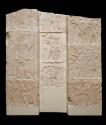Advanced Search
False door stele of Senwehem
Egyptian
Old Kingdom, Dynasty 6
2323–2150 B.C.
Findspot: Egypt, Giza, Tomb G 2132
Medium/Technique
Limestone
Dimensions
Overall: 184.2 x 80 x 27.9 cm, 723.94 kg (72 1/2 x 31 1/2 x 11 in., 1596 lb.)
Mount (Steel pallet and back support): 193.4 x 90.8 x 43.2 cm (76 1/8 x 35 3/4 x 17 in.)
Mount (Steel pallet and back support): 193.4 x 90.8 x 43.2 cm (76 1/8 x 35 3/4 x 17 in.)
Credit Line
Harvard University—Boston Museum of Fine Arts Expedition
Accession Number27.444
CollectionsAncient Egypt, Nubia and the Near East
ClassificationsArchitectural elements – False doors
One of the essential features of Old Kingdom tombs was the false door, a carved representation of a doorway, through which the Egyptians believed the ka, or sprit, of the deceased could pass between the tomb and the afterlife. Typically, the top of the false door was decorated with an image of the tomb, while the jambs were inscribed with offering prayers. On this example, figures with captions replace the usual columns of inscription. Senwehem, the deceased, appears prominently at the top of each doorjamb. Smaller registers below and in the central niche feature members of his family engaged in various activities. One of the earliest hairdressing scenes in Egyptian art occurs in the second register down on the jamb to the viewer's left.
DescriptionRelief stele of Senwehem. Lintel, two jambs, log lintel, and door panel, all inscribed. Serdab slit under log lintel. Lower part missing.
ProvenanceFrom Giza, tomb G 2132. 1910: excavated by the Harvard University-Museum of Fine Arts Expedition; 1927: assigned to the MFA by the Egyptian government.

















